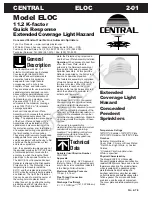
Design
Criteria
The Model ELOC ECLH Concealed Pendent Sprinklers are UL and C-UL listed and NYC Approved (MEA 7-95-E), for use in
light hazard occupancies, using the design criteria in Table 1 as well as any additional requirements specified in current
NFPA 13 Standards for Extended Coverage Pendent Sprinklers.
The Model ELOC ECLH Concealed Pendent Sprinklers are only listed with the Series ELOC Concealed Cover Plates. The
minimum lateral spacing between the ELOC ECLH Concealed Pendent Sprinkers, to prevent cold soldering, is 8 feet
(2,4 m).
The Model ELOC ECLH Concealed Pendent Sprinklers may be used with the "Clean Room Seal", see data sheet 28-4.0.
The use of this seal changes the thermal sensitivity from quick response to standard response.
The Support Cup of the Model ELOC ECLH Concealed Pendent Sprinkler has several slots in the base of the cup which
allows heat from a fire to flow past the thermal sensitive operating element accelerating sprinkler activation. Due to the
presence of these slots, the installation of these sprinklers in ceilings which have positive pressure in the space above, is
not permitted.
Minimum
Spacing Flow/Pressure Temperature Rating
LH (0.1 gpm/sq. ft.)
16' x 16' 30.0 gpm / 7.2 psi 160
°
F/71
°
C Sprinkler - 135
°
F/57
°
C Plate
(4,9m x 4,9m) 113,6 Lpm / 0,50 bar 212
°
F/100
°
C Sprinkler - 165
°
F/74
°
C Plate
18' x 18' 33.0 gpm / 8.7 psi 160
°
F/71
°
C Sprinkler - 135
°
F/57
°
C Plate
(5,5m x 5,5m) 124,9 Lpm / 0,60 bar 212
°
F/100
°
C Sprinkler - 165
°
F/74
°
C Plate
Table 1 - UL and C-UL Listing Criteria for the Installation of Model ELOC
Extended Coverage Light Hazard Concealed Pendent Sprinklers
Installation
The Model ELOC ECLH Concealed
Pendent Sprinklers must be installed
in accordance with the following
instructions.
NOTES
A leak tight 3/4 inch NPT sprinkler
joint should be obtained with a torque
of 10 to 20 ft.lbs. (13,4 to 26,8 Nm). A
maximum of 30 ft.lbs. (40,7 Nm) of
torque is to be used to install 3/4 inch
NPT sprinklers. Higher levels of
torque may distort the sprinkler inlet
with consequent leakage or impair-
ment of the sprinkler.
Do not attempt to make up for
insufficient adjustment in the escutch-
eon plate by under- or overtightening
the sprinkler. Readjust the position of
the sprinkler fitting to suit.
Step 1. The sprinkler must only be
installed only in the pendent position
and with the centerline of the sprinkler
perpendicular to the mounting
surface.
Step 2. Remove the Protective Cap.
Step 3. With pipe thread sealant
applied to the pipe threads, hand
tighten the sprinkler into the sprinkler
fitting.
Step 4. Wrench tighten the Sprinkler
using only the ELOC Sprinkler
Wrench (Ref. Figure 4). The ELOC
Sprinkler Wrench is to be applied to
the Sprinkler Wrench flats only.
Step 5. Replace the Protective Cap
by pushing it upwards until it bottoms
out against the Support Cup. The
Protective Cap helps prevent
dammage to the Deflector and Arms
during ceiling installation and/or
during application of the finish coating
of the ceiling. It may also be used to
locate the center of the clearance
holes by gently pushing the ceiling
material up against the center point of
the Protective Cap.
NOTE
As Long as the Protective Cap
remains in place, the system is
considered to be "Out of Service"
Step 6. After the ceiling has been
completed with the 2-1/2 inch
(66,7 mm) diameter clearance hole
and in preparation for installing the
Cover Assembly, remove and discard
the Protective Cap, and verify that the
Deflector moves up and down freely.
If the Sprinkler has been damaged
and the Deflector does not move up
and down freely, replace the entire
Sprinkler Assembly. Do not attempt
to modify or repair a damaged
sprinkler.
Step 7. Screw on the Cover Plate/
Retainer Assembly until its flange just
comes in contact with the ceiling. Do
not continue to screw on the Cover
Plate/Retainer Assembly such that it
lifts a ceiling panel out of its normal
position. If the Cover Plate/Retainer
Assembly cannot be engaged
sufficiently to contact the ceiling, the
sprinkler fitting must be repositioned.
OBSOLETE






















